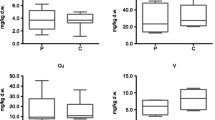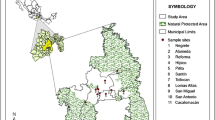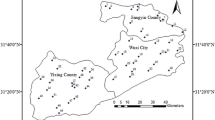Abstract
Following up-to-date initiatives of the Stockholm Convention, its global monitoring plan, and the International Cooperative Programme on Natural Vegetation and Crops (ICP Vegetation 2015) under the convention on long-range transboundary air pollution, this study examined 17 polychlorinated biphenyls (PCBs) and seven organochlorine pesticides (OCPs) in the moss Hypnum cupressiforme Hedw. and topsoil sampled across Serbia. In the topsoil, OCPs ranged from 0.0158 to 9.6804 ng g−1 while concentrations of individual PCB congeners were in the range between 0.0185 and 0.3107 ng g−1. The levels of OCPs and PCBs in the moss H. cupressiforme ranged from 2.7785 to 23.9501 ng g−1, and from 0.4325 to 15.8013 ng g−1, respectively. POP relationships between topsoil and moss investigated by fugacity model equations indicated that the moss POP enrichment was a result of atmospheric long-range transport rather than secondary reemissions from soil.

Similar content being viewed by others
References
Aničić Urošević, M., Vuković, G., & Tomašević, M. (2017). Pollution using mosses and lichens, a passive and active approach, state of the art research and perspectives. New York, NY: Nova Science Publishers.
Badea, S.-L., Mustafa, M., Lundstedt, S., & Tysklind, M. (2014). Leachability and desorption of PCBs from soil and their dependency on pH and dissolved organic matter. Science of the Total Environment, 499, 220–227.
Bartoš, T., Čupr, P., Klánová, J., & Holoubek, I. (2009). Which compounds contribute most to elevated airborne exposure and corresponding health risks in the Western Balkans? Environmental International, 35, 1066–1071.
Cabrerizo, A., Dachs, J., Barcelo, D., & Jonest, K. C. (2012). Influence of organic matter content and human activities on the occurrence of organic pollutants in Antarctic soils, lichens, grass, and mosses. Environmental Science and Technology, 46, 1396–1405.
Dvoršćak, M., Stipičević, S., Mendaš, G., Drevenkar, V., Medunić, G., Stančić, Z., et al. (2019). Soil burden by persistent organochlorine compounds in the vicinity of a coal-fired power plant in Croatia: A comparison study with an urban-industrialized area. Environmental Science and Pollution Research, 26, 23707–23716.
Fernández, J. A., Boquete, M. T., Carballeira, A., & Aboal, J. R. (2015). A critical review of protocols for moss biomonitoring of atmospheric deposition: Sampling and sample preparation. Science of the Total Environment, 517, 132–150.
Frankki, S., Persson, Y., Tysklind, M., & Skyllberg, U. (2006). Partitioning of CPs, PCDEs, and PCDD/Fs between particulate and experimentally enhanced dissolved natural organic matter in a contaminated soil. Environmental Science and Technology, 40, 6668–6673.
Frontasyeva, M. V., Steinnes, E., & Harmens, H. (2017). Monitoring long-term and large-scale deposition of air pollutants based on moss analysis. In M. Aničić Urošević, G. Vuković, & M. Tomašević (Eds.), Biomonitoring of air pollution using mosses and lichens, a passive and active approach, state of the art research and perspectives. New York, NY: Nova Science Publishers.
Grimalt, J. O., Borghini, F., Sanchez-Hernandez, J. C., Barra, R., Torres Garcia, C. J., & Focardi, S. (2004). Temperature dependence of the distribution of organochlorine compounds in the mosses of the Andean Mountains. Environmental Science and Technology, 38, 5386–5392.
Harmens, H., Foan, L., Simon, V., & Mills, G. (2013). Terrestrial mosses as biomonitors of atmospheric POPs pollution: A review. Environmental Pollution, 173, 245–254.
Harner, T., Bidleman, T. F., Jantunen, L. M. M., & Mackay, D. (2001). Soil-air exchange model of persistent pesticides in the United States cotton belt. Environmental Toxicology and Chemistry, 20, 1612–1621.
Herceg Romanić, S., Kljaković-Gašpić, Z., Bituh, T., Žužul, S., Dvoršćak, M., Fingler, S., et al. (2016). The impact of multiple anthropogenic contaminants on the terrestrial environment of the plitvice lakes national park Croatia. Environmental Monitoring and Assessment, 188, 1–16.
Holoubek, I., Dušek, L., Sáňka, M., Hofman, J., Čupr, P., Jarkovský, J., et al. (2009). Soil burdens of persistent organic pollutants–Their levels, fate and risk. Part I. Variation of concentration ranges according to different soil uses and locations. Environmental Pollution, 157, 3207–3217.
Holoubek, I., Klánová, J., Jarkovský, J., & Kohoutek, J. (2007). Trends in background levels of persistent organic pollutants at Kosetice observatory, Czech Republic—Part II. Aquatic air and terrestrial environments 1996–2005. Journal of Environmental Monitoring, 9, 564–571.
Kosior, G., Přibylová, P., Vaňková, L., Kukučka, P., Audy, O., Klánová, J., et al. (2017). Bioindication of PBDEs and PCBs by native and transplanted moss Pleurozium schreberi. Ecotoxicology and Environmental Safety, 143, 136–142.
Li, Y.-F., Harner, T., Liu, L., Zhang, Z., Ren, N.-Q., Jia, H., et al. (2010). Polychlorinated biphenyls in global air and surface soil: Distributions, air-soil exchange, and fractionation effect. Environmental Science and Technology, 244, 2784–2790.
Li, Y. F., Zhulidov, A. V., Robarts, R. D., Korotova, L. G., Zhulidov, D. A., Gurtovaya, T., et al. (2006). Dichlorodiphenyltrichloroethane usage in the former Soviet Union. Science of the Total Environment, 357, 138–145.
Lopez-Avila, V., & Luque de Castro, M. D. (2014). Microwave-assisted extraction. In J. Reedijk (Ed.), elsevier reference module in chemistry, molecular sciences and chemical engineering. Waltham, MA: Elsevier.
Moeckel, C., Nizzetto, L., Di Guardo, A., Steinnes, E., Freppaz, M., Filippa, G., et al. (2008). Persistent organic pollutants in boreal and montane soil profiles: Distribution, evidence of processes and implications for global cycling. Environmental Science and Technology, 42, 8374–8380.
Omar, M. L., Alharbi, A. A. B., Khattab, R. A., & Imran, A. (2018). Health and environmental effects of persistent organic pollutants. Journal of Molecular Liquid, 263, 442–453.
Petrović, M., Sremački, M., Radonić, J., Mihajlović, I., Obrovski, B., & Vojinović Miloradov, M. (2018). Health risk assessment of PAHs, PCBs and OCPs in atmospheric air of municipal solid waste landfill in Novi Sad, Serbia. Science of the Total Environment, 644, 1201–1206.
Pokhrel, B., Gong, P., Wang, X., Chen, M., Wang, C., & Gao, S. (2018). Distribution, sources, and airesoil exchange of OCPs, PCBs and PAHs in urban soils of Nepal. Chemosphere, 200, 532–541.
Ren, X., Zeng, G., Tang, L., Wang, J., Wan, J., Liu, Y., et al. (2018). Sorption, transport and biodegradation—An insight into bioavailability of persistent organic pollutants in soil. Science of the Total Environment, 610–611, 1154–1163.
Republic Hydrometeorological Service of Serbia, (2018). Annual Report. sector of the national center for climate change, climate model development and risk assessment natural disasters, Retrieved September, 2019, from http://www.hidmet.gov.rs/podaci/meteorologija/latin/2017.pdf.
Sakan, S., Ostojić, B., & Đorđević, D. (2017). Persistent organic pollutants (POPs) in sediments from river and artificial lakes in Serbia. Journal of Geochemical Exploration, 180, 91–100.
Sparr Eskilsson, C., & Björklund, E. (2000). Analytical-scale microwave-assisted extraction. Journal of Chromatography A, 902, 227–250.
Stockholm Convention for Persistent Organic Pollutants, (2001). Retrieved August, 2019, from http://chm.pops.int/.
Storer, D. A. (1984). A simple high-sample-volume ashing procedure for determination of soil organic matter. Communications in Soil Science and Plant Analysis, 15, 759–772.
Tarcau, D., Cucu-Man, S., Boruvkova, J., Klanova, J., & Covaci, A. (2013). Organochlorine pesticides in soil, moss and tree-bark from North-Eastern Romania. Science of the Total Environment, 456–457, 317–324.
Turk, M., Jakšić, J., Vojinović Miloradov, M., & Klanova, J. (2007). Post-war levels of persistent organic pollutants (POPs) in air from Serbia determined by active and passive sampling methods. Journal of Environmental Monitoring, 5, 109–113.
United Nations Economic Commission for Europe (UNECE), (2016). Moss monitoring manual, international cooperative programme on effects of air pollution on natural vegetation and crops (ICP Vegetation), Moss Survey Coordination Centre, Frank Laboratory of Neutron Physics, Joint Institute for Nuclear Research, Dubna, Russian Federation, 2016. Moss survey protocol, Retrieved from, https://icpvegetation.ceh.ac.uk/get-involved/manuals/moss-survey. Accessed 22 Jan 2020.
United Nations Environment Programme (UNEP), (2004). From conflict to sustainable development assessment of environmental hot spots Serbia and Montenegro. Retrieved September, 2019, from, https://postconflict.unep.ch/publications/assessment.pdf.
Wu, Q., Wang, X., & Zhou, Q. (2014). Biomonitoring persistent organic pollutants in the atmosphere with mosses: Performance and application. Environmental International, 66, 28–37.
Zhu, D., Hyun, S., Pignatello, J. J., & Lee, L. S. (2004). Evidence for π–π electron donor–acceptor interactions between π–donor aromatic compounds and π–acceptor sites in soil organic matter through pH effects on sorption. Environmental Science and Technology, 38, 4361–4368.
Zhu, N., Schramm, K.-W., Wang, T., Henkelmann, B., Fu, J., Gao, Y., et al. (2015). Lichen, moss and soil in resolving the occurrence of semi-volatile organic compounds on the southeastern Tibetan Plateau, China. Science of the Total Environment, 518–519, 328–336.
Funding
The research was supported by the Croatian Science Foundation (Project OPENTOX, No. 8366) . The authors acknowledge funding provided by the Institute of Physics Belgrade, through the grant by the Ministry of Education and Science of the Republic of Serbia (Projects Nos. III43007, III43002 and 172001).
Author information
Authors and Affiliations
Contributions
Not applicable.
Corresponding author
Ethics declarations
Conflict of interest
The authors declare that they have no conflict of interest.
Additional information
Publisher's Note
Springer Nature remains neutral with regard to jurisdictional claims in published maps and institutional affiliations.
Electronic supplementary material
Below is the link to the electronic supplementary material.
Table S1.
The concentrations [ng g−1] of organochlorine pesticides (OCPs) and indicator polychlorinated biphenyls (PCBs) determined in the soil sampled at 21 sampling sites across Serbia. Table S2. Spearman’s correlation coefficients between concentrations of organochlorine pesticide (OCPs) and indicator polychlorinated biphenyl (PCBs), and soil properties (soil organic matter − SOM and pH); significant correlations are given in bold. Table S3. The concentrations [ng g−1] of organochlorine pesticides (OCPs) and indicator polychlorinated biphenyls (PCBs) determined in the moss H. cupressiforme sampled at 21 sampling sites across Serbia. (DOCX 36 kb)
Rights and permissions
About this article
Cite this article
Mendaš, G., Herceg Romanić, S., Jovanović, G. et al. Organochlorines burden in moss H. cupressiforme and topsoil across Serbia. Environ Geochem Health 43, 273–283 (2021). https://doi.org/10.1007/s10653-020-00704-1
Received:
Accepted:
Published:
Issue Date:
DOI: https://doi.org/10.1007/s10653-020-00704-1




